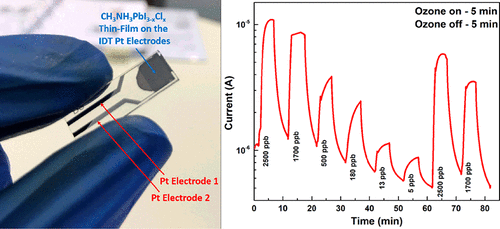
Various types of Sensors have established their presence in every budding technology. Sensing technologies not only used in technological advancement but also have wide acceptance in both commercial as well as public safety, for monitoring environment and air conditioning appliances and systems. Ozone is one of the principal pollutant considered harmful to the environment and human health.
Researchers have successfully demonstrated an ozone sensing material (CH3NH3PbI3–xClx ) which can be operated at low temperatures, without the need of an external source for recovery. It is compatible with flexible as well as static substrate. Its sensing properties depend on changes in its electrical properties. Hybrid lead halide based perovskite films are portable, flexible and can be operated at room temperature. It is self –powered and ultrasensitive towards ozone.
The researchers demonstrated a thin film with thickness ∼300 nm based hybrid lead mixed halide perovskite planar ozone sensor. This thin film can be applied to any substrate or in flexible substrate by the method of printable technique or spin coating which will result in sending element.

For fulfilling the need of clean ozone technology, it is important to control and monitor its concentration with effective and inexpensive methods. Techniques used for ozone control and monitoring should be capable of measuring concentrations in the range of <0.01–10 ppm. The earlier analytical methods used to determine ozone concentration like optical, UV absorbance, chemiluminescence, fluorescence, and electrochemical methods have limitations as these methods do not provide real-time measurement and fail to detect the small concentrations ( few ppb) of ozone. Many Ozone sensors have been already proposed in literature but they need higher temperature to operate and were not idle for self-powered devices as they have to be switched on to detect the desired gas molecule.
Features of sensing element
- Able to operate in room temperature
- Self-powered (no requirement of external switching)
- Detect small concentrations of ozone, highly sensitive
It will be a breakthrough in the field of wearable optoelectronics and its sensing applications can be applied in fields like personalized noninvasive medicine and defense purposes.



















